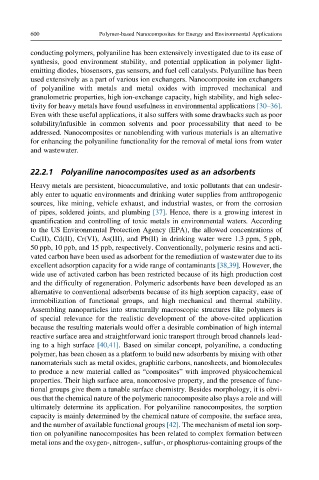Page 650 - Polymer-based Nanocomposites for Energy and Environmental Applications
P. 650
600 Polymer-based Nanocomposites for Energy and Environmental Applications
conducting polymers, polyaniline has been extensively investigated due to its ease of
synthesis, good environment stability, and potential application in polymer light-
emitting diodes, biosensors, gas sensors, and fuel cell catalysts. Polyaniline has been
used extensively as a part of various ion exchangers. Nanocomposite ion exchangers
of polyaniline with metals and metal oxides with improved mechanical and
granulometric properties, high ion-exchange capacity, high stability, and high selec-
tivity for heavy metals have found usefulness in environmental applications [30–36].
Even with these useful applications, it also suffers with some drawbacks such as poor
solubility/infusible in common solvents and poor processability that need to be
addressed. Nanocomposites or nanoblending with various materials is an alternative
for enhancing the polyaniline functionality for the removal of metal ions from water
and wastewater.
22.2.1 Polyaniline nanocomposites used as an adsorbents
Heavy metals are persistent, bioaccumulative, and toxic pollutants that can undesir-
ably enter to aquatic environments and drinking water supplies from anthropogenic
sources, like mining, vehicle exhaust, and industrial wastes, or from the corrosion
of pipes, soldered joints, and plumbing [37]. Hence, there is a growing interest in
quantification and controlling of toxic metals in environmental waters. According
to the US Environmental Protection Agency (EPA), the allowed concentrations of
Cu(II), Cd(II), Cr(VI), As(III), and Pb(II) in drinking water were 1.3 ppm, 5 ppb,
50 ppb, 10 ppb, and 15 ppb, respectively. Conventionally, polymeric resins and acti-
vated carbon have been used as adsorbent for the remediation of wastewater due to its
excellent adsorption capacity for a wide range of contaminants [38,39]. However, the
wide use of activated carbon has been restricted because of its high production cost
and the difficulty of regeneration. Polymeric adsorbents have been developed as an
alternative to conventional adsorbents because of its high sorption capacity, ease of
immobilization of functional groups, and high mechanical and thermal stability.
Assembling nanoparticles into structurally macroscopic structures like polymers is
of special relevance for the realistic development of the above-cited application
because the resulting materials would offer a desirable combination of high internal
reactive surface area and straightforward ionic transport through broad channels lead-
ing to a high surface [40,41]. Based on similar concept, polyaniline, a conducting
polymer, has been chosen as a platform to build new adsorbents by mixing with other
nanomaterials such as metal oxides, graphitic carbons, nanosheets, and biomolecules
to produce a new material called as “composites” with improved physicochemical
properties. Their high surface area, noncorrosive property, and the presence of func-
tional groups give them a tunable surface chemistry. Besides morphology, it is obvi-
ous that the chemical nature of the polymeric nanocomposite also plays a role and will
ultimately determine its application. For polyaniline nanocomposites, the sorption
capacity is mainly determined by the chemical nature of composite, the surface area,
and the number of available functional groups [42]. The mechanism of metal ion sorp-
tion on polyaniline nanocomposites has been related to complex formation between
metal ions and the oxygen-, nitrogen-, sulfur-, or phosphorus-containing groups of the

